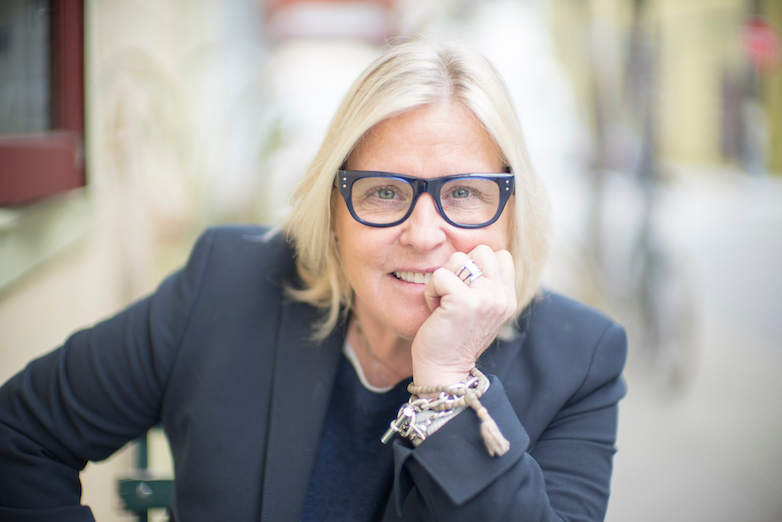Save 50% on a 3-month Digiday+ membership. Ends Dec 12.
‘Thorns and roses’: A day in the life of Amy Errett, CEO for hair-coloring brand Madison Reed

Amy Errett wants to give the $15 billion hair-coloring industry a new do.

Watching her wife Clare color her roots every two weeks caused Errett, founder and CEO for hair-color brand Madison Reed, to worry: Errett couldn’t help wondering how many dangerous chemicals were in the dye and worried that it would affect the health of not only her wife but that of more than 100 million women in the U.S. who dye their hair every year.
“I’m very concerned about ingredients,” she said. “If you color your hair today, you either go to Duane Reade where you get horrible experience, ingredients and cheap boxes. Or you go to a salon where you spend over $200 and sit there for three hours. Still, you don’t know your products.”
So she founded her own hair color company Madison Reed in 2014, and sells products mainly online at a price range of $25 to $30. All the 45 colors are made in Italy, with each being named after a city in the country. “We have the lowest chemical profile that exists in the market today,” said Errett, who dyed her hair with the color Roma Blonde.
Three weeks ago, Madison Reed opened its first Color Bar — where people can get touch-ups in 45 minutes for $45 — in New York City. Errett said that the company’s revenue doubled last year and is projected to double again this year, though she declined to share the baseline. The goal of 2017 is to open four Color Bars in the U.S.
Madison Reed is Errett’s fourth company. Before that, she was a venture capitalist focusing on direct-to-consumer businesses and led the Series A investment in General Assembly. She also chairs the board of the Glide Foundation, the largest social service organization in San Francisco with $20 million budget.
We caught Errett at the Madison Reed Color Bar on Thursday and asked her to walk us through a recent typical day.
6 a.m.: I get up and check my two phones, iPhone 7 and Google Pixel. I look at my email, text to see if there’s anything urgent and then check our sales numbers. Before workout, I also look at all the reviews on Net Promoter Score [a management tool that measures a company’s customer loyalty] from a day before to see what consumers are talking about our brand.
6:20 a.m.: I work out at the gym in my house for around 45 minutes.
7:15 a.m.: I drive my daughter Madison to school and then go to the office.
9:00-10:30 a.m.: I drive to my alma mater The Wharton School in San Francisco and speak on a panel about business in front of 80 undergraduates.
12:00 p.m.: I come back to the office and have lunch with the entire company. We have been serving lunch on Monday since day one.
12:25 p.m.: I stand up in front of the whole company and share what’s going on in the business. I talk about numbers, partnerships, events I plan to attend this week and our first pop-up store in New York City, etc. I also introduce two new hires to everyone and welcome them to join the team. And then I spend 10 minutes taking questions.
1:00 p.m.: I have our weekly executive meeting. We go around the table and see how everyone is doing against key objectives, what is on track and what is in danger. The business is growing so rapidly that there are problems every week. Our biggest issue today is that there is more opportunity than time, so I spend lots of time saying, “No, focus on this and keep our priorities really tight.”
2:30 p.m.: I have a meeting with our CFO to go over key stats.
3:30 p.m.: I have a meeting with our head of product to review the product pipeline, talking about what products we are going to introduce this and next year.
4:30 p.m.: I have a meeting with investment bankers.
6:00 p.m.: I get to do my emails. On an average day, I have around 1,000 emails. I read every single consumer interaction. I usually pick five customers on Saturday and write them a personal email, but today I don’t need to do that.
7:00 p.m.: I go home at 7. When I’m home, I help Madison with math. She is getting better at math, but it is not her strength yet. So we have our 30-minute math session every night during the week. She is applying for high school right now, very stressful time.
7:30 p.m.: Dinner time. My wife Clare is a chef, so she cooks for us, which is nice. When we are having dinner together, we do the same thing every day, which we call “thorns and roses”: “Thorns” are things that are not good happened today, while “roses” are things that are good. Our dog has been very sick, and he is very young, so most of our “thorns” recently are about how to deal with the process. Our “roses” are that we have each other and we are grateful for what we have.
I also share my “thorns and roses” at work with my family. The company is named after my daughter — Madison is her first name and Reed is her middle name — so she asks every day when I’m home, “Mommy, how are WE doing?” I need to report to her. She is only 13.
9:00 p.m.: After Madison goes to bed, Clare and I can finally catch up on our own day. I organize my life around sports. I tape all the games: basketball, baseball and football. Tonight I watch a basketball game at my alma mater, UPenn. Sometimes we watch completely senseless TV. Clare likes watching “The Bachelor,” and I’m like, “That’s stupid and I cannot believe it.” But I still watch the show with her because I just need to take a break from work.
10:00-11:00 p.m.: I spend an hour cleaning my inbox. I never go to sleep with any remaining emails because I’m very organized and cannot stand having stuff from yesterday when I wake up.
Store image courtesy of Madison Reed
Amy Errett headshot courtesy of Madison Reed / Christopher Michel
More in Marketing

In Graphic Detail: Here’s what the creator economy is expected to look like in 2026
Digiday has charted its expected revenue, key platforms for creator content as well as what types of creators brands want to work with.

Ulta, Best Buy and Adidas dominate AI holiday shopping mentions
The brands that are seeing the biggest boost from this shift in consumer behavior are some of the biggest retailers.

Future of Marketing Briefing: AI confuses marketers but their own uncertainty runs deeper
That was the undercurrent at this week’s Digiday Programmatic Marketing Summit in New Orleans.








